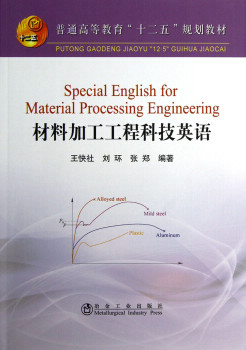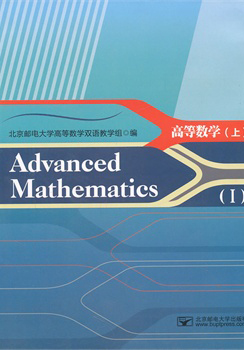焊接科学与工程专业英语(吴志生)
定价:¥28.00
作者: 吴志生
出版时间:2018年3月
出版社:化学工业出版社
- 化学工业出版社
- 9787122154583
- 175169
- 2018年3月
- 本科材料
- 本科
内容简介
本教材主要介绍焊接技术与工程专业的基础知识和专业知识英语文献。该教材内容大部分选自国外原版教材,教材共分九章,内容包括焊接技术与工程专业知识的诸多方面的英语文献。内容涉及现代工程结构材料、金属材料的力学性能及热物理性能、钢的热处理、电弧物理等焊接技术基础知识,以及弧焊电源、焊接方法及设备、焊接冶金学、焊接工艺、焊接应力与变形、焊接自动化及焊接质量检验等焊接专业知识。
本书为高等院校焊接专业学生专用教材,也可以供从事焊接技术与工程领域工作的工程技术人员参考。
本书为高等院校焊接专业学生专用教材,也可以供从事焊接技术与工程领域工作的工程技术人员参考。
目录
Chapter 1 Welding Technology Fundamental1.1 Modern Engineering Structural Material1.2 Mechanical Property of Metal Material1.3 Thermophysical Property of Metal Material1.3.1 Specific Heat1.3.2 Thermal Expansion1.3.3 Thermal Conductivity1.3.4 Melting Point or Melting Range1.3.5 Thermionic Work Function1.4 Principal Types of Heat Treatment of Steel1.5 Arc Physics1.5.1 Stability of Electric Arc1.5.2 Stability of AC ArcChapter 2 Arc Welding Power Source2.1 Classification of Power Source2.1.1 AC Power Supplies2.1.2 DC power supplies2.1.3 Inverse Source of Arc Welding2.2 Electrical Characteristics of Power Source2.2.1 Constant Voltage2.2.2 Constant Current2.2.3 Combined Constant?Current and Constant VoltageCharacteristics2.3 Selecting and Specifying a Power SourceChapter 3 Arc Welding Process3.1 Shielded Metal?Arc Welding3.2 Gas Shielded?Arc Welding3.2.1 Specific Advantages of Gas?shielded Arc3.2.2 Types of Gas?Shielded Arc Processes3.2.3 Gas Tungsten Arc?Tig3.2.4 Gas Metal Arc?Mig3.2.5 CO2 Welding3.2.6 Pulsed Arc Welding3.3 Submerged Arc Welding Fundamentals of the process3.3.1 Definition and general description3.3.2 Principles of operation3.4 Plasma Arc Welding3.4.1 Keyhole Action3.4.2 Arc Shaping3.4.3 Operating Data3.4.4 Applications3.4.5 SummaryChapter 4 Other Welding Methods4.1 Resistance Welding4.1.1 Introduction4.1.2 Resistance Spot Welding(RSW)4.1.3 Projection Welding4.1.4 Resistance Seam Welding(RSEW)4.1.5 Upset Butt Welding4.1.6 Flash Butt Welding4.2 Friction Stir Welding4.2.1 Introduction4.2.2 Principles4.2.3 Friction Stir Tool4.2.4 Friction Stirring Imperfections4.3 Laser Beam Welding4.3.1 Introduction4.3.2 Principles4.3.3 Metals Welded4.3.4 Machines4.3.5 Parameters and Technology4.4 Electron Beam Welding4.4.1 Introduction4.4.2 Principles4.4.3 Variations4.4.4 Equipment4.4.5 SafetyChapter 5 Welding Metallurgy5.1 Chemical Reactions in Welding5.1.1 Overview5.1.2 Gas?Metal Reactions5.1.3 Slag?Metal Reactions5.2 Weld Metal Solidification5.2.1 Epitaxial Growth at Fusion Boundary5.2.2 Nonepitaxial Growth at Fusion Boundary5.2.3 Competitive Growth in Bulk Fusion Zone5.2.4 Effect of Welding Parameters on Grain Structure5.2.5 Weld Metal Nucleation Mechanisms5.2.6 Grain Structure Control5.3 The Microstructure and Properties of Heat?affected Zone5.3.1 Welding Thermal Cycle5.3.2 The Microstructure Changes in the HAZ5.3.3 Hardness Distribution in the HAZ5.3.4 Welding Cracks in the HAZChapter 6 Weldability of Material6.1 Weldability of Material and Testing Method6.1.1 Weldability of Material6.1.2 Weldability Evaluation and Test Method6.2 Weldability of low carbon steel6.2.1 Metallurgy of the liquid weld metal6.2.2 Solidification and solidification cracking6.2.3 Stress intensification,embrittlement and cracking of fusionwelds below the solidus6.2.4 Lamellar tearing6.2.5 Reheat Cracking6.3 Weldability of Magnesium and Its Alloys6.3.1 Alloys and Welding Procedures6.3.2 Oxide Film Removal6.3.3 Cracking6.3.4 Mechanical Properties6.3.5 Corrosion Resistance and Fire RiskChapter 7 Residual Stresses,Distortion and Fatigue7.1 Residual stresses7.1.1 Development of residual stresses7.1.2 Analysis of Residual Stresses7.2 Distortion7.2.1 Cause7.2.2 Remedies7.3 Fatigue7.3.1 Mechanism7.3.2 Fractography7.3.3 S?N Curves7.3.4 Effect of Joint Geometry7.3.5 Effect of Stress Raisers7.3.6 Effect of Corrosion7.3.7 Remedies7.4 Case Studies7.4.1 Failure of a Steel Pipe Assembly7.4.2 Failure of a Ball MillChapter 8 Automation of Welding8.1 Introduction of Automatic Welding System8.2 Flexible Automation of Welding8.3 ARC Welding Robots8.3.1 Introduction8.3.2 Robot Manipulator Configuration8.3.3 Robot Welding Application8.3.4 Buying a Welding Robot8.3.5 Robot Safety8.4 Controls for Automatic Arc Welding8.4.1 Automatic Welding Controllers8.4.2 Robot Controllers8.4.3 Teaching the Robot8.4.4 Robot Memory8.4.5 Weld Execution8.5 Sensors and Adaptive Control8.5.1 Introduction8.5.2 Contact Sensors8.5.3 Noncontact Sensor Systems8.6 Tooling and FixturesChapter 9 Welding Quality Inspection9.1 Welding Defects9.1.1 Definition and Types9.1.2 Cracks9.1.3 Porosity9.1.4 Solid Inclusion9.1.5 Lack of Fusion and Inadequate or incomplete penetration9.1.6 Imperfect Shape9.2 Non?destructive Testing9.2.1 Radiographic Testing9.2.2 Ultrasonic Testing(UT)9.2.3 Magnetic Particle Inspection(MPI)9.2.4 Liquid Penetrant Testing(PT)9.3 Destructive Test9.3.1 Tension Tests9.3.2 Bend Tests9.3.3 Charpy Tests9.3.4 Hardness Testing9.4 Radiograph Interpretation9.4.1 General Welding Discontinuities9.4.2 Other DiscontinuitiesReferences











